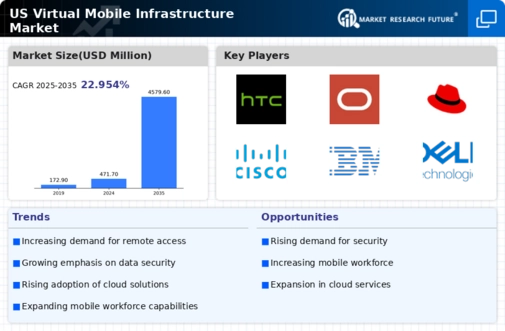The virtual mobile-infrastructure market is currently characterized by intense competition and rapid technological advancements. Key growth drivers include the increasing demand for remote work solutions, the proliferation of mobile devices, and the need for enhanced security measures. Major players such as VMware (US), Citrix Systems (US), and Microsoft (US) are strategically positioned to leverage these trends. VMware (US) focuses on innovation through its cloud-based solutions, while Citrix Systems (US) emphasizes partnerships to enhance its service offerings. Microsoft (US) continues to expand its Azure platform, integrating advanced AI capabilities to improve user experience. Collectively, these strategies contribute to a dynamic competitive environment, where agility and technological prowess are paramount.
In terms of business tactics, companies are increasingly localizing manufacturing and optimizing supply chains to enhance efficiency and responsiveness. The market structure appears moderately fragmented, with several key players exerting considerable influence. This fragmentation allows for niche players to emerge, yet the collective strength of major companies shapes the overall competitive landscape, driving innovation and setting industry standards.
In October 2025, VMware (US) announced a strategic partnership with a leading telecommunications provider to enhance its mobile infrastructure solutions. This collaboration aims to integrate advanced network capabilities with VMware's cloud services, potentially improving service delivery and customer satisfaction. Such partnerships are crucial as they enable companies to expand their market reach and enhance their technological offerings, thereby solidifying their competitive positions.
In September 2025, Citrix Systems (US) launched a new suite of security features designed specifically for mobile applications. This initiative reflects a growing emphasis on cybersecurity within the virtual mobile-infrastructure market. By prioritizing security, Citrix Systems (US) not only addresses customer concerns but also differentiates itself from competitors, potentially attracting a broader client base.
In August 2025, Microsoft (US) unveiled enhancements to its Azure platform, incorporating machine learning algorithms to optimize mobile application performance. This move underscores Microsoft's commitment to integrating AI into its offerings, which may provide a competitive edge in an increasingly digital landscape. The ability to leverage AI for improved performance could be a game-changer, positioning Microsoft (US) as a leader in innovation within the market.
As of November 2025, current competitive trends are heavily influenced by digitalization, sustainability, and AI integration. Strategic alliances are increasingly shaping the landscape, allowing companies to pool resources and expertise. Looking ahead, competitive differentiation is likely to evolve, with a shift from price-based competition to a focus on innovation, technology, and supply chain reliability. Companies that can effectively harness these trends will likely emerge as leaders in the virtual mobile-infrastructure market.

















Leave a Comment